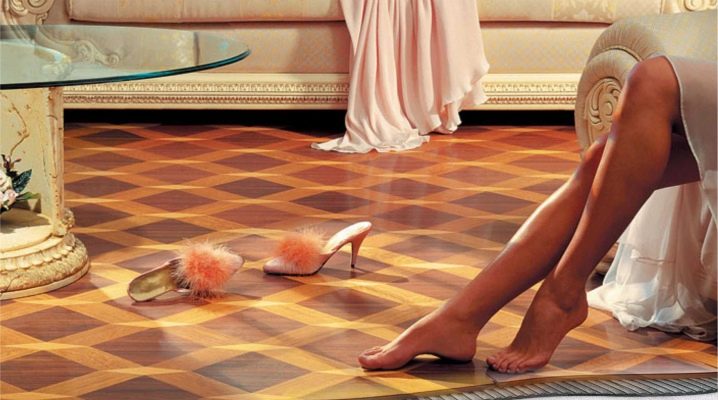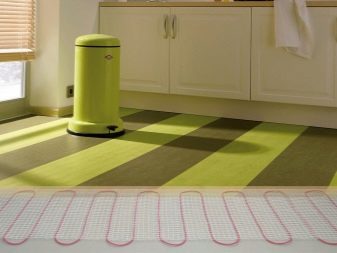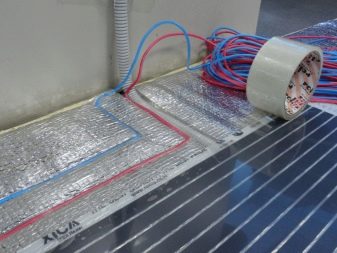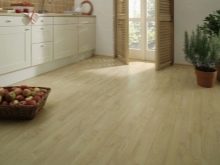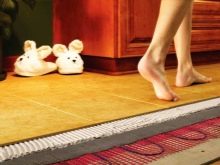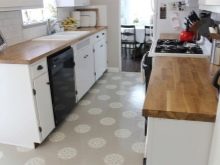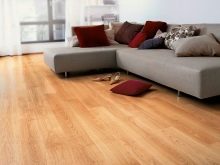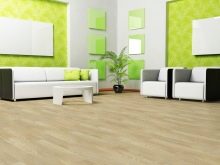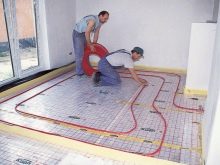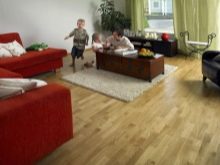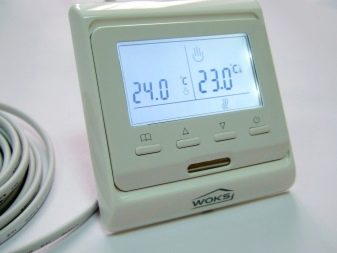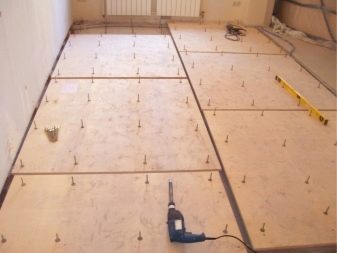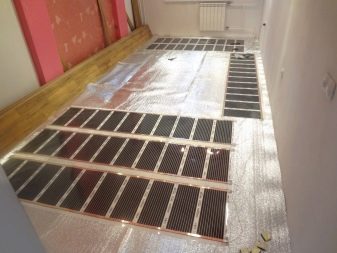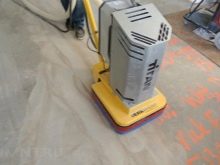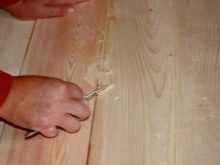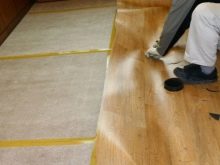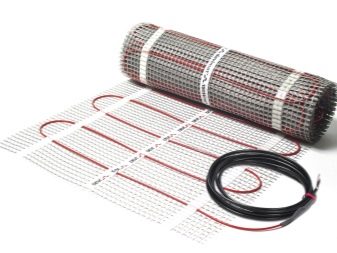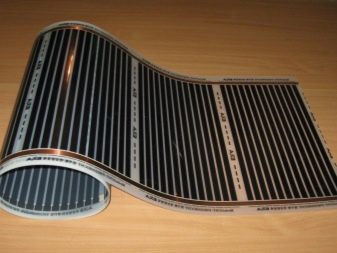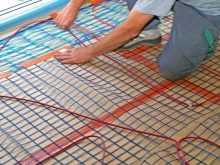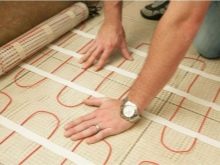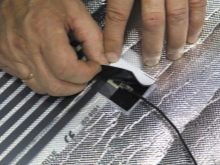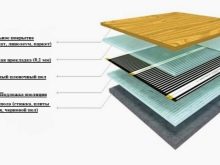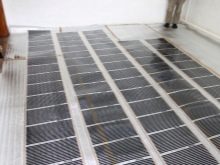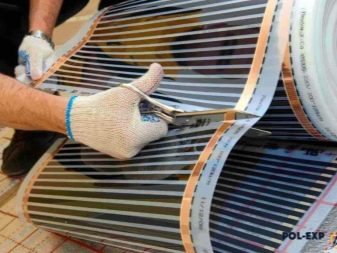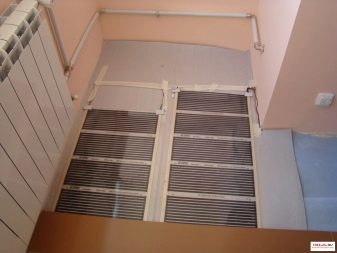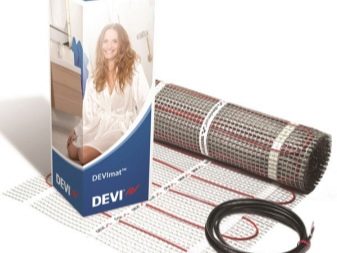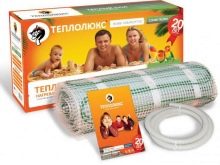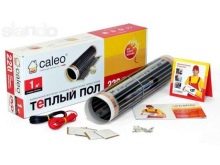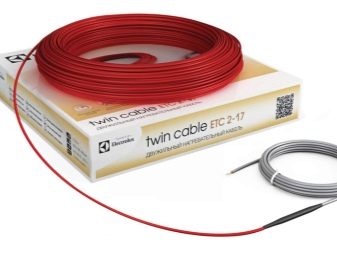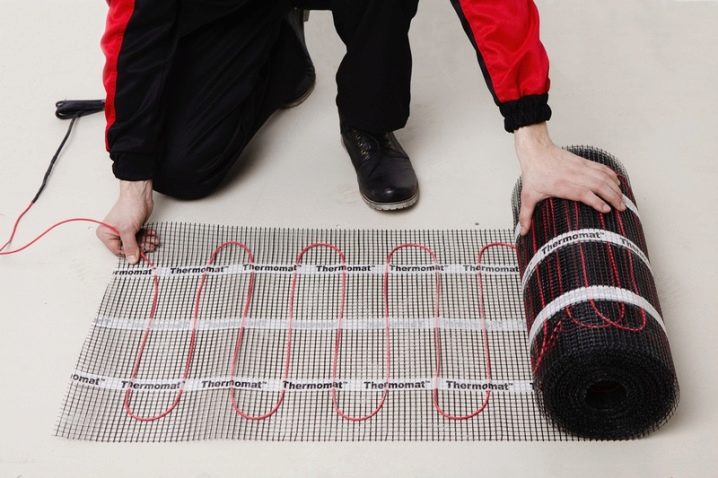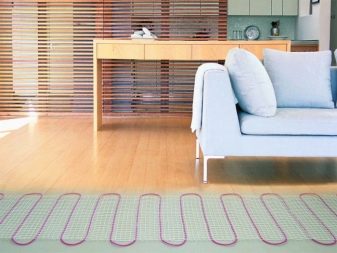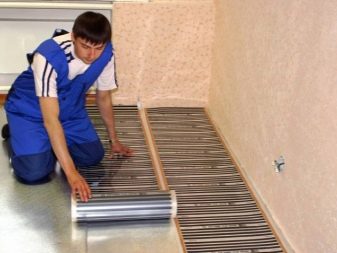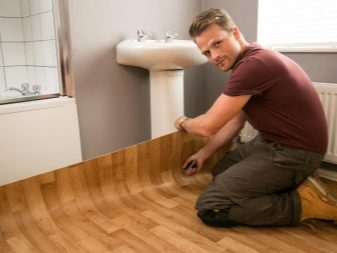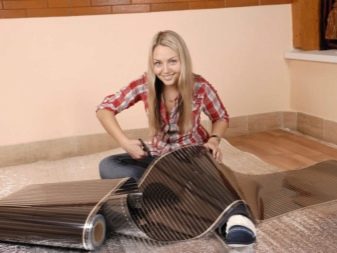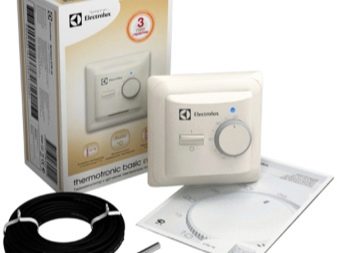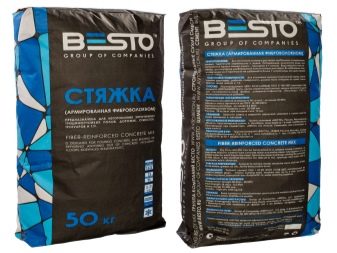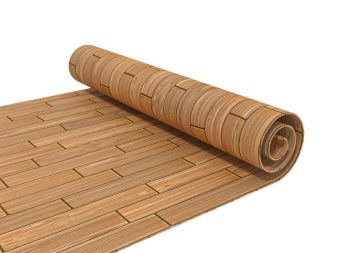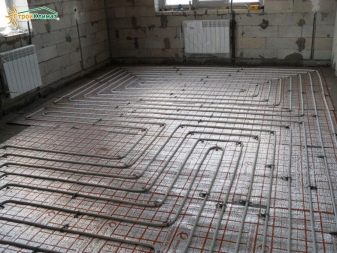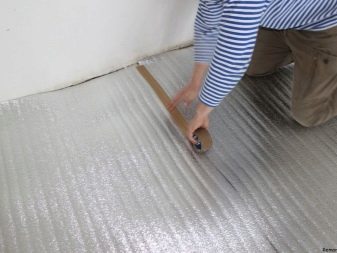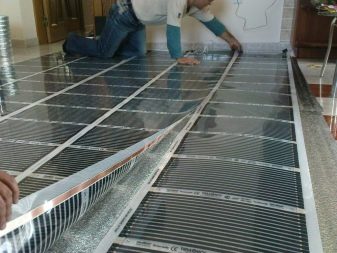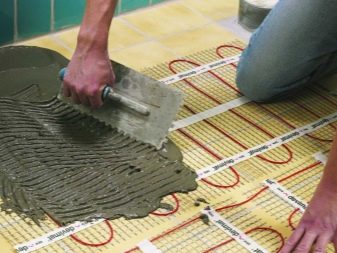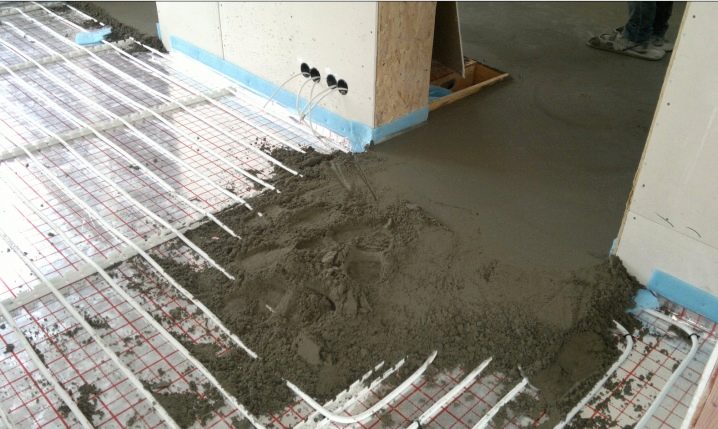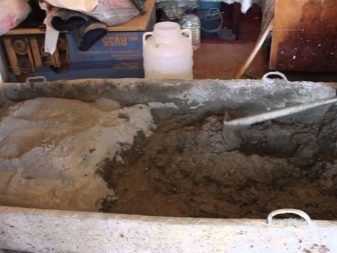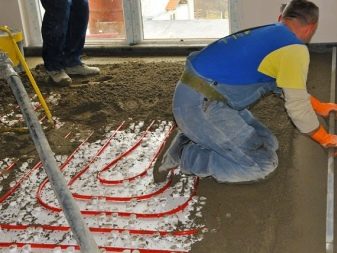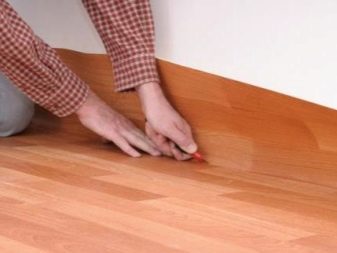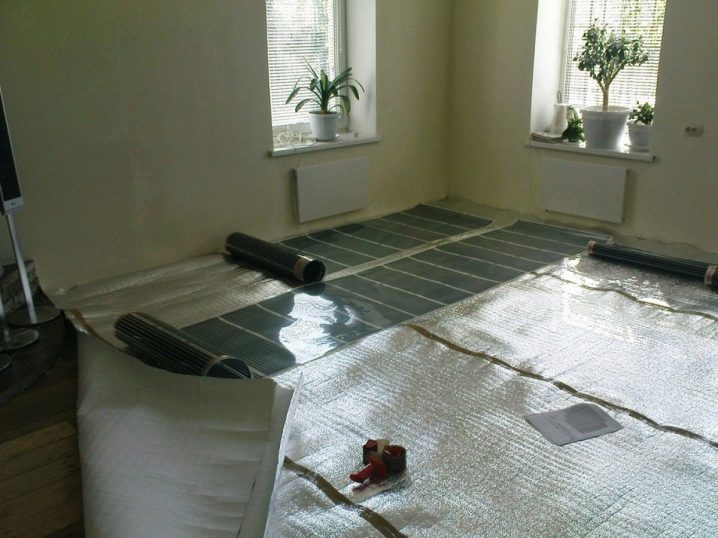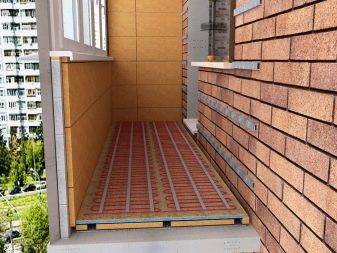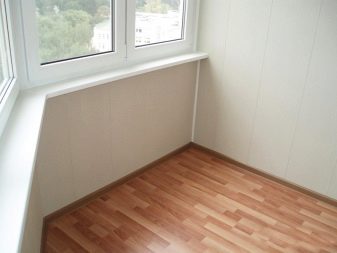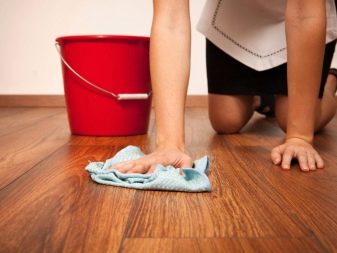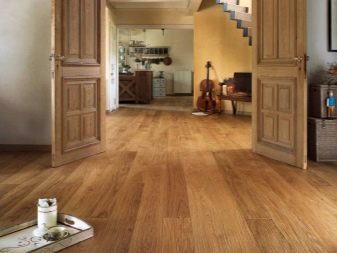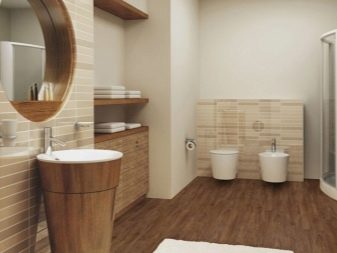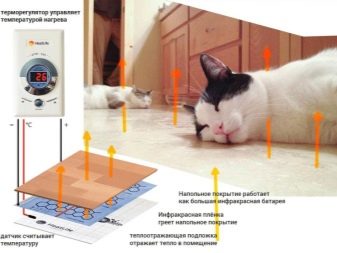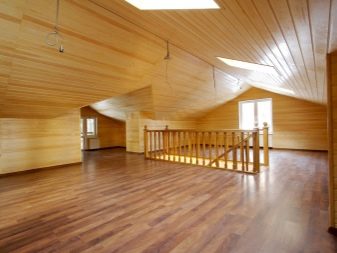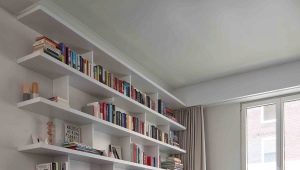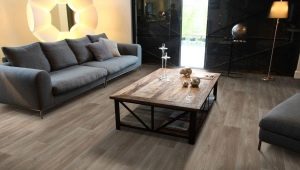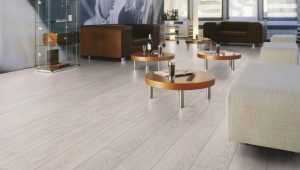Warm floor under linoleum
When performing repairs, it is often necessary to install a “warm floor”, as well as laying on such a floor of linoleum. Many people think about how safe and practical it is.
What it is?
The heated floor system is a special floor construction that allows for space heating, and sometimes even serves as a complete replacement for the usual heating devices (batteries, radiators, near-window heating systems). Heated floors can also be used for local heating (for example, a kitchen work area or bathroom). In these cases, the main heating role will play the battery.
If a choice is made in favor of installing a “warm floor” and covering it with linoleum, it can be said with confidence that the decision is correct, because This heating system has a number of undeniable advantages:
- uniform temperature in all parts of the room (heat is distributed from the bottom up, without creating a greenhouse effect: the system prevents it from being retained in certain areas);
- compared to conventional batteries and radiators, does not have convection;
- saving free space in the room (especially important for small apartments);
- provides safety during operation (useful property for those who have small children, because there is no risk of getting burned);
- comfort during operation (creates a feeling of comfort and warmth all year round);
- environmental friendliness (electricity does not harm the environment);
- due to the absence of convection currents, it prevents the additional distribution of dust in space, as it happens with conventional heating systems (important for asthmatics and people with allergies);
- relatively inexpensive and easy installation of the system (can be done independently).
As for the shortcomings or, rather, the nuances that need to be taken into account during the installation and subsequent operation of the heating system of this type, should pay attention to the following:
- the high cost of electricity (especially in winter, when heating is required around the clock), but based on calculations of the costs of different types of heating systems, experts concluded that underfloor heating does not increase the price of heating in a typical residential building;
- the use of thermostats (you should also install the sensors on the wall during installation and install a temperature controller);
- the difficulty of accessing the system in case it has failed (it is often necessary to dismantle the entire floor to determine the cause of the breakdown, and this is not only difficult, but also expensive, because you will need to completely change the heating system and floor);
- economic inexpediency for rooms with a large area (to fill a large room with heat, a lot of electricity is required, especially if there are panoramic windows in this room).
Is it possible to lay?
So, it was decided to lay warm floors. Pay attention to what the floor is made of and think whether it is possible to mount a heating system on it. For example, in houses or old apartments, as a rule, the flooring is made of boards, and you need to replace the old coating with linoleum, while adding heating.Of course, there will be a logical question about the possibility of installing a heating system on wooden flooring, and on top - linoleum. It turns out it's possible the main thing is to choose and install the system correctly so that it does not affect the subfloor.
Usually when installing a warm floor on a wooden or concrete flooring using plywood. Pre-floor is covered with such sheets, fastened together with metal clips, and the plywood is not attached to the base.
Thus, putting warm floors on plywood, you can control the changes that occur with wood under the influence of heat. On the concrete screed mount plywood thickness of 12-15 mm. Slabs of more than 15 mm thick are laid on the wooden floor, sometimes thin sheets are put in two layers.
It is not worth laying a warm floor on linoleum of an old sample without preliminary covering it with plywood. The material may become deformed and, worse, produce an unpleasant toxic smell. If we are talking about modern brands of linoleum, you need to check its compatibility with heating elementswhether this material is suitable for underfloor heating (as a rule, there is a permissive marking on the packaging for linoleum).The same types of linoleum are used when it is planned to make it a topcoat for a heated floor or install a heating structure under the carpet.
If you decide to warm the tiled floor in the kitchen or bathroom, during installation you need to follow all the recommendations, carefully grind the subfloor, putty the joints so that the finish is even and beautiful.
Types of warm floors
Everyone knows what comfort and coziness warm floors give, especially during the winter and off-season. But not everyone knows that these systems also provide energy savings. This floor can be used as an independent heating system (for the southern regions of the country), and as an additional source of heat in the offseason or in regions with harsh winters. The effect of electrical heating systems is heat flux generated by electricity. Electric heated floor can be cable (heated by a special electric cable) and film (has a heating film).
Electrical cables are both self-regulating and resistive. By choosing one or another type of cable, you can adjust the power consumption and the heating temperature. The device of a cable floor is similar to "sandwich".A polyethylene film is stretched onto the floor coating leveled and ground (if necessary), the material holding the heat (thermal insulation) and the reflective cloth creeps upwards, then an electrical heating system is installed, which is covered with a metallized grid, and the floor is screed. To regulate the temperature, at the time of installation, they take the wires to the wall and make the adjustment unit at a convenient height.
When performing a screed on an electrically heated floor, the following requirement must be observed: its thickness must allow heat rays to reach the floor surface. Usually it is 5-7 cm. If you violate this rule, the floor will run empty.
If the electric heating is film, then it will be enough to fill the floor with a thin one, since this type of system is less powerful than cable. When all the work on pouring and screed is done, you need to wait until the surface dries out (often it takes quite a long time), and only then lay down the topcoat - linoleum.
If we consider the infrared electric floor heating, you need to keep in mind one positive thing: the materialwhich is the basis of this type of system (carbon fiber in the form of carbon fiber rod) has the function of self-regulation, therefore the floor is protected from overheating. On the infrared option is convenient to lay any coverage.and linoleum is no exception. Infrared systems are not very powerful, and they are usually put on an already flooded floor using glue.
Such constructions are so simple that you can even install them yourself, especially when all the “dirty” work on pouring and floor screed has been completed. Plus, the fact is that during a regular repair or in the event of a system breakdown, it is easy to dismantle or replace it with a working one without the help of a specialist.
Sometimes people choose local heating to reduce costs. Infrared tape profile is cut into fragments and placed in those areas that should be warmer. Such an economical and reasonable device of a warm floor allows you to create coziness in the working areas of the kitchen or in the bathroom for minimal money.
It turns out that warm floor systems are not a luxury at all. An affordable finish, such as everyone's favorite linoleum, makes them even more affordable.
Manufacturers review and reviews
Before buying an electric cable for a warm floor, you need to measure the room and draw out a laying pattern to determine what quantity is required. When choosing a manufacturer, you should carefully read the reviews and recommendations of professionals so that in the end the warm floor will serve for a long time and without fail. Since the choice in the construction market is colossal, it is easy to make a mistake when buying, therefore Pay attention to the following well-known and already proven manufacturers:
- Devi - Danish manufacturer of electrical cable, which has been present on the market for over 20 years and stands out among its competitors with high quality products and reasonable prices. Users note the durability of the warm flooring from a Danish electrical cable. There are no reviews that these products have failed, and the floor went down. In this case, the manufacturer provides a guarantee on their products, and Devi service centers can be found in almost any city. Also, these cables are economical and they do not dry the air.
- If we consider the IR cables, you should pay attention to the Korean company Caleo. Products of this manufacturer are not cheap, but they are made of high quality materials.
- The infrared cable of the Russian brand is widely known. "Heatlux". This manufacturer is known not only in the domestic market, but also in the foreign market, which indicates the high quality and safety of its products.
- Among the most economical IR tapes are the products of the English manufacturer. Energy. Despite the fact that its products are expensive, in the future energy savings will be noticeable, so buying for the future is a very smart move. This fact made the company's cables, perhaps the most popular among all.
How to choose?
Everyone knows that it is forbidden to install a heated floor in apartments, therefore electric systems are more often chosen (their area of use is much wider). There are two types of electrical systems for underfloor heating:
- heating cable;
- heating mat.
A heating cable generates heat per unit of its length. When calculating it, you can roughly estimate what the heating value will be. For this type of system, the presence of a screed or a thin cast is required, respectively, the floor level will slightly rise. However, the power consumed by the cable is small relative to the second type.
As for the mat, it is a thin cable attached to a special grid. For this system, do not tie. The mat is quite suitable for a dense flooring: tile, linoleum. Installation of the system is simpler than the first option, and this is an advantage for those who are going to install the floor on their own.
It is also important to choose how the air temperature in the room will be regulated. There are automatic sensors that measure the temperature inside the room. Along with automatic self-regulating sensors, those that measure the temperature near the floor are in demand. Since the air flow rises, it is easy to estimate that, having set the floor temperature to 30 degrees, the room will eventually warm up to about 25 degrees. Thus, it is possible to choose the system suitable for the room.
It is also important to take into account the fact that in the places where the furniture will be installed, it is not necessary to do the heating, under the bathroom and sinks they do not put under floor heating either. When planning the installation, it is necessary to take into account the need to make an indent from the wall before laying the cable.
If a warm floor is chosen as the main source of heating, then you should plan the location of the furniture so that it eventually occupies about 3/4 of the entire room, otherwise the system will not perform its heating function properly.
How to put your own hands?
The heated floor system has long become familiar to a wide range of people with different incomes. It is present in modern household space in the house, in the attic or on the balcony for quite a long time, which allowed to evaluate the device from different sides, to understand its principles and independently master the method of installation. And how to do everything quickly and avoid mistakes follow step-by-step instructions already proven in practice.
Training
First, from the room where you plan to install a warm floor, you need to remove all the furniture, and then dismantle the old floor: remove the floor, clean the rough floor from dust, polish rough irregularities. If necessary, you can make a tie. It is necessary to determine the wall where the temperature controller will be led.
It is advisable to provide a warm floor with separate wiring in order to avoid short circuits in the whole apartment in case of problems.When the preparatory work is completed, you can proceed to the practical side of the issue of installing a heated floor.
What is needed?
To perform the installation of heated floor will need to use the following equipment and auxiliary materials:
- selected type of electrical system (cable or IR ribbon mat);
- reflective material;
- substrate (if necessary);
- waterproofing film;
- protective mesh;
- temperature sensor and adjustment unit;
- materials for floor screed;
- plywood sheets (if necessary);
- selected linoleum type;
- cord for hot welding;
- stapler with staples;
- construction level and pencil.
Installation
As mentioned earlier, an electric floor heating system consists of several layers, each of which performs an important function. First, the heat insulator is laid. Depending on which floor the room is located on, you can choose a heat insulator of the appropriate thickness.
If the material does not have a reflective layer (for example, preference is given to natural cork insulation), then on top of it should put a metallized substrate. It will ensure that heat is stored in the space under the floor and will prevent its leakage. The substrate is chosen either from polyester fiber or from aluminum (the second option is somewhat more expensive and is not always necessary).
Next comes the installation of the heating system itself. Electrical cables or infrared tapes are placed on the floor surface at the same distance from each other, having previously determined the step. Depending on what type of system is chosen, fix it in an accessible way: cables - with the help of clamps, and the heating tapes are glued to the substrate. After the installation of the system is completed, the wire for the thermostat is removed to the selected wall.
Next, fixed on the floor of the electrical system is covered with a special protective grid. This material reflects the heat and ensures the reliability of the installation, preventing the negative impact of large loads on it (heavy furniture or equipment), which can bring the floor to warm down. It is possible to use this grid as a grounding conductor, having previously removed the connecting wires to the place intended for this in the floor.
So the system is ready. This is followed by screed and laying of the finishing coating.
Please note that before performing the screed and pouring, it is necessary to check the working capacity and serviceability several times on different parts of the floor, identify shortcomings in the design and eliminate them while there is still access to the system. Otherwise, it is necessary to dismantle and break the ready-made screed.
How to perform a coupler?
Fix the warm floor with a cement screed. Wet option consists of cement, water, sand, concrete components. The composition of the dry screed additionally make special plasticizers, which allow to achieve the desired characteristics of the composition:
- uniform density and lack of pores. This allows you to increase the efficiency of the heated floor (the heat will not linger in the formed internal voids, but will be completely transferred to the outside of the floor);
- surface strength. Since overall objects (furniture, appliances) will subsequently be placed on the floor, cracks may occur on the floor, leading to breakage of the heating system. Special components added to the cement screed make it possible to avoid this in the future.
- uniform freezing.If the composition of the screed is initially prepared incorrectly (it has not been thoroughly mixed, it is not evenly distributed over the surface), then in the future it is impossible to avoid delamination of the floor and the appearance of cracks (they can form when the screed sets during drying).
Since the screed layer for underfloor heating should not be thick, you need to correctly select the components for it. When choosing cement, you should focus on those brands that will provide guaranteed strength. They point to packs, so it will be difficult to make a mistake. It is better not to experiment with plasticizers, and take ready in the hardware store. When choosing sand, you should pay attention to the coarse-grained. Such a material will increase the strength of the solution.
Of course, you can buy a ready-made composition of the screed and dilute it with water in the right proportions, but if the task is to save, it’s easy to make the mixture yourself, the main thing is to choose the right ingredients.
Put the solution on the floor surface with a thin layer (although for the pipeline in the water heating system a thicker layer is allowed, up to 5 cm) using a special paddle.To make the thickness uniform at all sites, a construction level is used, they are checked for uniformity of the screed and, if necessary, while it has not yet begun to set, level the defects and eliminate defects. When the screed layer is applied, the floor is left to dry, and the heating is by no means included in order to avoid uneven curing. This may cause cracking. On average, the period of hardening of the screed varies from two weeks to a month.
How to lay linoleum?
As soon as the screed has dried, the warm floor is ready for finishing. The most difficult work is over, and after they are done laying linoleum will not cause any problems. The floor before the lining with its linoleum is once again cleaned of dust, eliminating all the disadvantages. If cracks have formed, they are thoroughly putty, and when the putty dries, a couple of layers of waterproofing are laid. The hydro insulator is a dense polyethylene film. If the base of the floor is wooden, then insulation from moisture is not needed., the tree copes with this task on its own.
When the concrete floor is insulated from moisture, linoleum can be laid.Measure the length and width of the floor, then measure these values on the canvas of linoleum (with a margin under the baseboard about 5 cm on each side). If the room is large and the linoleum is narrow, two sheets are laid, the joints are joined by cold welding. Next, cut off all unnecessary and install skirting and corners.
If suddenly a tile that looks not quite presentable was glued to the warm floor, but there is no money for updating it, you can use thin linoleum just by laying it over the tile. In this case, it is necessary to lay a layer of jute substrate between the tile and linoleum so that surfaces do not slip.
How to avoid mistakes?
Most of the errors when installing a warm floor and laying linoleum occurs at the time of installation of energy on the floor, so it will be useful to take into account a couple of tips to avoid unpleasant situations:
- before you install an electrical cable, draw a diagram of its installation;
- do not plug in the cable until it is laid on the floor;
- clean the floor thoroughly to avoid dust and odor;
- do not step on the cable;
- Leave the temperature sensor above the level of the screed.
If the installation work with the flooring is to be done for the first time, then from the first time it is very difficult to cope with the task yourself. It is better to hire specialists and reassign the work to them.
To learn how to install a warm floor under the linoleum with your own hands, see the following video.
Examples and options
Warm flooring is extremely popular, they are used almost everywhere. With their help, it is possible to improve living conditions, to create coziness, and sometimes even to expand the space of an apartment, because, having provided the territory of the balcony with such a heating system, it can be made part of the living space. Even if you do not combine a balcony with a room, a heated floor will still be useful. To go to the balcony during the cold season is not a problem, because a warm floor protects against discomfort and helps to preserve health.
Also on this balcony you can place animals at night and not worry about them. Heated loggia can instantly turn into a cozy corner for relaxation or a study, even in a harsh winter.
The undeniable advantages of this residential space heating system are:
- safe and comfortable conditions for children and pets (and those, and others often spend time,playing on the floor);
- creation of a microclimate corresponding to individual wishes using a temperature controller;
- help to avoid mold (prevent the occurrence of moisture, which is especially important for homes in the marshland);
- ease of care (just wash the floors, do not need to spend time cleaning radiators);
- safety (the probability of getting a burn is absent);
- increasing the useful space in the room (the room becomes more adapted to the placement of furniture in it according to the preferences of the residents, although earlier everything was limited to batteries);
- in areas with severe winters, warm floors additionally warm the house;
- durability of work.
Warm floor covered with linoleum, it is useful to use in obviously dirty areas: in the kitchen, in the hallway and corridor. This coating will provide easy floor maintenance with simple detergents. Unlike laminate, which often cover underfloor heating, there will be no dirty areas on linoleum (the dirt is easily clogged in the inter-axle space). In addition, linoleum can be used as a budget option for covering this type of floor in the bathroom.It will protect the heating system from moisture no worse than tile.
Useful will be the use of a warm floor with a linoleum coating in the attic. If the attic is open, then in order not to freeze in the offseason, you can turn on the heated floor only at the time of staying on it, because the round-the-clock work here is inappropriate. Heating will not fully perform its function, but will only increase the monthly payment for electricity. If you have a dog or cat that sleeps on the floor, then the benefits of electric heating are indisputable.
For people who do not want to spend money on equipping the entire surface with heating, but to create comfort for their pet, there is a great idea - to equip with electric or water heating system only that portion of the floor that serves as a bed for the animal. The local location is appropriate in the bathroom and in the kitchen near the work area.
Underfloor heating system is an excellent solution for almost any type of housing, it gives comfort and coziness to everyone, from small children to favorite pets.
